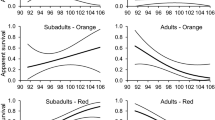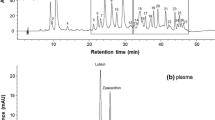Abstract
In the context of sexual selection and parent-offspring communication, carotenoid-based coloration operates as a dynamic condition-dependent signal, as pigments stored in the skin and in the bill can be reallocated to other tissues in accordance with physiological needs. We studied the proximate factors affecting the carotenoid-dependent coloration of the Eurasian kestrel (Falco tinnunculus). Kestrel nestlings show carotenoid-based coloration at the integument level. Adult males and females share similar characteristics, but to a different extent. By cross-fostering nestlings, we evaluated the importance of the “nest of rearing” and the “nest of origin” to determine variation in skin color and blood carotenoids. The nest of rearing accounted for most of the observed variance in skin color, as well as serum carotenoids, while the nest of origin was not causal to the variability of carotenoids in young kestrels. The study indirectly shows that carotenoid-based color expressed by young kestrels is not affected by pre-laying conditions. Furthermore, we found that carotenoid coloration and blood carotenoid concentration were correlated at phenotypic and environmental levels, while the hereditary component of the carotenoid traits was too low to estimate their correlation at the genetic level.
Similar content being viewed by others
References
Alonso-Alvarez C, Bertrand S, Devevey G, Gaillard M, Prost J, Faivre B, Sorci G (2004) An experimental test of the dose-dependent effect of carotenoids and immune activation on sexual signals and antioxidant activity. Am Nat 164:651–659
Alves-Rodrigues A, Shao A (2004) The science behind lutein. Toxicol Lett 150:57–83
Biard C, Surai PF, Møller AP (2007) An analysis of pre- and post-hatching maternal effects mediated by carotenoids in the blue tit. J Evol Biol 20:326–339
Blount JD, Metcalf NB, Birkhead R, Surai PF (2003) Carotenoid modulation of immune function and sexual attractiveness in zebra finches. Science 300:125–127
Bortolotti GR, Tella JL, Forero MG, Dawson RD, Negro JJ (2000) Genetics local environment and health as factors influencing plasma carotenoids in wild American kestrels (F. sparverius). Proc R Soc Lond B 267:1433–1438
Bortolotti G, Fernie K, Smits JE (2003) Carotenoid concentration and coloration of American kestrels (Falco sparverius) disrupted by experimental exposure to PCBs. Funct Ecol 17:651–657
Brawner WR III, Hill GE, Sundermann CA (2000) Effects of coccidial and mycoplasmal infections on carotenoid-based plumage pigmentation in male house finches. Auk 117:952–963
Bright A, Waas JR, King CM, Cuming PD (2004) Bill colour and correlates of male quality in blackbirds: an analysis using canonical ordination. Behav Proc 65:123–132
Brush AH (1990) Metabolism of carotenoid pigments in birds. FASEB 4:2969–2977
Casagrande S, Csermely D, Pini E, Bertacche V, Tagliavini J (2006) Skin carotenoid concentration correlates with male hunting skill and territory quality in the kestrel (Falco tinnunculus). J Avian Biol 37:190–196
Casagrande S, Costantini D, Fanfani A, Tagliavini J, Dell’Omo G (2007) Patterns of plasma carotenoid accumulation and skin colour variation in nestling kestrels in relation to breeding conditions and different terms of carotenoid supplementation. J Comp Physiol B 177:237–245
Costantini D, Dell’Omo G (2006) Environmental and genetic components of oxidative stress in wild kestrel nestlings (Falco tinnunculus). J Comp Physiol B 176:575–579
Costantini D, Casagrande S, Di Lieto G, Fanfani A, Dell’Omo G (2005a) Consistent differences in feeding habits between neighbouring breeding kestrels. Behaviour 142:1403–1415
Costantini D, Dell’Omo G, Casagrande S, Fabiani A, Carosi M, Bertacche V, Marquez C, Snell H, Snell H, Tapia W, Gentile G (2005b) Inter-population variation of carotenoids in Galapagos land iguanas (Conolophus subcristatus). Comp Biochem Physiol Part B 142:239–244
Costantini D, Casagrande S, De Filippis S, Brambilla G, Fanfani A, Tagliavini J, Dell’Omo G (2006) Correlates of oxidative stress in wild kestrel nestlings (Falco tinnunculus). J Comp Physiol B 176:329–337
Costantini D, Coluzza C, Fanfani A, Dell’Omo G (2007) Effects of carotenoid supplementation on colour expression oxidative stress and body mass in rehabilitated captive adult kestrels (Falco tinnunculus). J Comp Physiol B 177:723–731
Duckworth RA, Mendonc MT, Hill GE (2004) Condition-dependent sexual traits and social dominance in the house finch. Behav Ecol 15:779–784
Eraud C, Devevey G, Gaillard M, Prost J, Sorci G, Faivre B (2007) Environmental stress affects the expression of a carotenoid-based sexual trait in male zebra finches. J Exp Biol 210:3571–3578
Faivre B, Grégoire A, Préault M, Cézilly F, Sorci S (2003) Immune activation rapidly mirrored in a secondary sexual trait. Science 300:103
Falconer DS (1989) Introduction to quantitative genetics. Longman Scientific and Technical, Essex, England
Fenoglio S, Cucco M, Fracchia L, Martinotti MG, Malacarne G (2004) Shield colours of the Moorhen are differently related to bacterial presence and health parameters. Ethol Ecol Evol 16:149–156
Figuerola J, Muños E, Gutiérrez R, Ferrer D (1999) Blood parasites leucocytes and plumage brightness in the Cirl bunting Emberiza cirlus. Funct Ecol 13:594–601
Fitze PS, Tschirren B, Richner H (2003) Carotenoid-based colour expression is determined early in nestling life. Oecologia 137:148–152
Gilmour AR, Gogel BJ, Cullis BR, Welham SJ, Thompson R (2002) ASReml user guide release 10. VSN International, Hemel, Hempstead
Götmark F, Ahlström M (1997) Parental preference for red mouth of chicks in a songbird. Proc R Soc Lond B 264:959–962
Grether GF, Hudon J, Millie DF (1999) Carotenoid limitation of sexual coloration along an environmental gradient in guppies. Proc R Soc Lond B 266:1317–1322
Griffith SC, Parker TH, Olson VA (2006) Melanin- versus carotenoid-based sexual signals: is the difference really so black and red? Anim Behav 71:749–763
Hadfield JD, Owens IPF (2006) Strong environmental determination of a carotenoid-based plumage trait is not mediated by carotenoid availability. J Evol Biol 19:1104–1114
Hadfield JD, Nutall A, Osorio D, Owens IPF (2008) Testing the phenotypic gambit: phenotypic genetic and environmental correlations of colour J Evol Biol (in press). doi: 101111/j1420–9101200601262x
Hill GE (1991) Plumage coloration is a sexually selected indicator of male quality. Nature 350:337–339
Hill GE (1999) Is there an immunological cost to carotenoid-based ornamental coloration? Am Nat 154:589–595
Hill GE, McGraw KJ (2004) Correlated changes in male plumage coloration and female mate choice in cardueline finches. Anim Behav 67:27–35
Hill GE, Inouye CY, Montgomerie R (2002) Dietary carotenoid predicts plumage coloration in wild house finches. Proc R Soc Lond B 269:1119–1124
Hõrak P, Vellau H, Ots I, Møller AP (2000) Growth conditions affect carotenoid-based plumage coloration of great tit nestlings. Naturwissenschaften 87:460–464
Hõrak PL, Ots I, Vellau H, Spottiswoode C, Møller AP (2001) Carotenoid-based plumage coloration reflects hemoparasites infection and local survival in breeding great tits. Oecologia 126:166–173
Hõrak P, Surai PF, Ots I, Møller AP (2004) Fat soluble antioxidants in brood-rearing great tits Parus major: relations to health and appearance. J Avian Biol 35:63–70
Inouye CY, Hill GE, Stradi RD, Montgomerie R (2001) Carotenoid pigments in male house finch plumage in relation to age subspecies and ornamental coloration. Auk 118:900–915
Jawor JMN, Gray N, Beall SM, Breitwisch R (2004) Multiple ornaments correlates with aspects of condition and behaviour in female Northern Cardinals Cardinalis cardinalis. Anim Behav 67:875–882
Johnsen A, Delhey K, Andersson S, Kempenaers B (2003) Plumage colour in nestling blue tits: sexual dichromatism condition dependence and genetic effects. Proc R Soc Lond B 270:1263–1270
Kilner R, Davies NB (1998) Nestling mouth colour: ecological correlates of a begging signal. Anim Behav 56:705–712
Kimura M (1958) On the change of population fitness by natural selection. Heredity 12:145–167
Koivula M, Viitala J, Korpimäki E (1999) Common kestrels prefer scent marks according to species and reproductive status of voles. Ecoscience 6:415–420
Koutsos EA, Clifford AJ, Calvert CC, Klasing KC (2003) Maternal carotenoid status modifies the incorporation of dietary carotenoids into immune tissues of growing chickens (Gallus gallus domesticus). J Nutr 133:1132–1138
Kruuk LEB, Hadfield JD (2007) How to separate genetic and environmental causes of similarity between relatives. J Evol Biol 20:1890–1903
Lessels CM, Boag PT (1987) Unrepeatable repeatabilities: a common mistake? Auk 104:116–121
Linville SU, Breitwusch R (1997) Carotenoid availability and plumage coloration in a wild population or northern cardinals. Auk 114:796–800
Mays HL, McGraw KJ, Ritchison G, Cooper S, Rush V, Parker RS (2004) Sexual dichromatism in the yellow-breasted chat Icteria virens: spectrophotometric analysis and biochemical basis. J Avian Biol 35:125–134
McGraw KJ, Hill GE (2000) Plumage brightness and breeding-season dominance in the house finch: a negatively correlated handicap? Condor 102:456–461
McGraw KJ, Ardia DR (2003) Carotenoids immunocompetence and the information content of sexual colors: an experimental test. Am Nat 162:704–712
McGraw KJ, Gregory AJ, Parker RS, Adkins-Regan E (2003) Diet plasma carotenoids and sexual coloration in the zebra finch (Taeniopygia guttata). Auk 120:400–410
McGraw KJ, Hill GE, Stradi R, Parker RS (2002) The effect of dietary carotenoid access on sexual dichromatism and plumage pigment composition in the American goldfinch. Comp Biochem Physiol B 131:261–269
Merilä J (1996) Genetic variation in offspring condition: an experiment. Funct Ecol 10:465–474
Merilä J, Sheldon BC (1999) Genetic architecture of fitness and nonfitness traits: empirical patterns and development of ideas. Heredity 83:103–109
Møller AP, Biard C, Blount JD, Houston DC, Ninni P, Surai PF (2000) Carotenoid-dependent signals: indicators of foraging efficiency immunocompetence or detoxification ability? Avian Poultry Biol Rev 11:137–159
Montgomerie R (2006) Analyzing colors In: Hill GE, McGraw KJ (eds) Bird coloration mechanisms and measurements, vol 1. Harvard University Press, Cambridge, pp 109
Mougeot F, Martínez-Padilla J, Pérez-Rodríguez L, Bortolotti G (2007) Carotenoid-based colouration and ultraviolet reflectance of the sexual ornaments of grouse. Behav Ecol Sociobiol 61:741–751
Mousseau TA, DA Roff (1987) Natural selection and the heritability of fitness components. Heredity 59:181–197
Navara KJ, Hill GE (2003) Dietary carotenoid pigments and immune function in a songbird with extensive carotenoid-based plumage coloration. Behav Ecol 14:909–916
Negro JJ, Tella JL, Blanco G, Forero MG, Garrido-Fernández J (2000) Diet explains interpopulation variation of plasma carotenoids and skin pigmentation in nestling white storks. Physiol Biochem Zool 73:97–101
Negro JN, Tella JL, Hiraldo F, Bortolotti GR, Prieto P (2001) Sex and age related variation in plasma carotenoids despite a constant diet in the red-legged partridge Alectoris rufa. Ardea 89:275–280
Olson VA, Owens IPF (1998) Costly sexual signals: are carotenoids rare risky or required? TREE 13:510–514
Olson VA, Owens IPF (2005) Interspecific variation in the use of carotenoid-based coloration in birds: diet life history and phylogeny. J Evol Biol 18:1534–1546
Prum RO, Torres R (2003) Structural coloration of avian skin: convergent evolution or coherently scattering dermal collagen arrays. J Exp Biol 206:2409–2429
Pryke SR, Andersson S (2003) Carotenoid-based epaulettes reveal male competitive ability: experiments with resident and floater red-shouldered widowbirds. Anim Behav 66:217–224
Pryke SR, Lawes MJ, Andersson S (2001) Agonistic carotenoid signalling in male red-collared widowbirds: aggression related to the colour signal of both the territory owner and model intruder. Anim Behav 62:695–704
Saino N, Ninni P, Calza S, Martinelli R, De Bernardi F, Møller AP (2000) Better red than dead: carotenoid-based mouth coloration reveals infection in barn swallow nestlings. Proc R Soc Lond B 267:57–61
Saino N, Ferrari R, Romano M, Martinelli R, Møller AP (2003) Experimental manipulation of egg quality affects immunity of barn swallow nestlings. Proc R Soc Lond B 270:2485–2489
Saks L, McGraw KJ, Hõrak P (2003) How feather colour reflects its carotenoid content. Func Ecol 17:555–561
Tschirren B, Fitze PS, Richner H (2003) Proximate mechanisms of variation in the carotenoid-based plumage coloration of nestling great tits (Parus major L). J Evol Biol 16:91–100
Acknowledgments
We thank Fiona Grant for revising the English version of the manuscript, Fernando Costantini for helping in data collection during the 2004 breeding season, Alberto Fanfani and Gianfranco Brambilla for their support of this research, two anonymous reviewers for valuable comments on the manuscript. Part of this work was sponsored by the scientific association Ornis italica. David Costantini was supported by a PhD fellowship issued from the University of Rome La Sapienza.
Author information
Authors and Affiliations
Corresponding author
About this article
Cite this article
Casagrande, S., Costantini, D., Tagliavini, J. et al. Phenotypic, genetic, and environmental causes of variation in yellow skin pigmentation and serum carotenoids in Eurasian kestrel nestlings. Ecol Res 24, 273–279 (2009). https://doi.org/10.1007/s11284-008-0503-3
Received:
Accepted:
Published:
Issue Date:
DOI: https://doi.org/10.1007/s11284-008-0503-3




